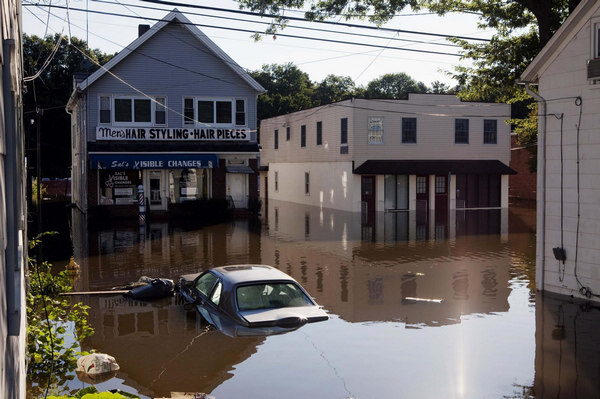Irene wallops floundering flood insurance program
Updated: 2011-08-31 10:45
(Agencies)
|
|||||||||||
NEW YORK - The only thing worse than getting flooded out of your home once is getting flooded out of it twice. Or, for that matter, over and over again.
Margaret Wert bought her Wayne, New Jersey house in 1999, relying on assurances from her realtor that any occasional flooding would only amount to an inch or two of water. A week after closing, Hurricane Floyd put four feet of water in her basement.
Earlier this year, Wert, 45, got flooded again and received a payout of $5,000 on her government flood insurance, which costs her $1,200 a year. It wasn't enough to cover her bills, but it helped with the new stove, refrigerator and boiler.
But all of Margaret Wert's new appliances and much of her house are now ruined, after Hurricane Irene flooded broad swathes of New Jersey. This time, though, she has a message for the government insurance program.
"If they don't buy me out and give me what I want, I am going to walk away, and they can keep it. I will tell the insurance company 'give the check to the bank.' You can do the repairs. You can live there in mold, you can live there in smell, I am done."
In the United States, uniquely in the developed world, insuring homeowners against flood damage is the sole province of the federal government. The National Flood Insurance Program (NFIP), which is administered by the Federal Emergency Management Agency, is virtually the only place to get protection against the disasters of flood and storm surge.
The problem is that the NFIP is a disaster itself, hanging on by a series of hard-fought annual extensions and the subject of a stalled reform bill in Congress. Only six years ago, taxpayers had to bail out the program after losses from Hurricane Katrina proved too much to handle.
But bailouts are not popular in Washington these days. With Congress locked in battle over the national deficit and recessionary fears looming, House Republicans are already warning that any extra money spent needs to be offset by cuts.
While Hurricane Irene was not as strong as Katrina, it has caused severe and widespread flooding in some of America's most populated - and most expensive - areas. The storm killed at least 38 people in 11 states, in addition to three who died in the Dominican Republic and one in Puerto Rico.
In New Jersey alone, Governor Chris Christie has estimated losses could be in the tens of billions of dollars. The state has nearly $52 billion in flood insurance in force from the NFIP.
The question is whether the NFIP can handle it, and whether the losses it faces from Irene are enough to spur the US Senate into passing a major reform bill that made it through the House of Representatives last month.
Moreover, if climate change believers in the insurance industry are right, and the environment is changing in unpredictable and severe ways, the flooding that results could worsen an already bad situation for the NFIP and for homeowners.
"What I do regret tremendously is because the federal government can undercut the private sector, it is now the only insurer in the floodplain management arena," said Joe Allbaugh, the former director of FEMA under President George W. Bush, who now runs his own disaster management company.
"It spends most of its time in the red. That's because it's another government program (where) the premiums that are charged are way under market value, in my opinion."
History
The NFIP dates to 1968, when Congress created it to help offset flood damage in quickly developing parts of the country, as well as to give communities an incentive to manage their flood risk more effectively.
From an insurance standpoint, the program is much like any other private-sector program: pay the government a certain amount and when a flood happens, receive coverage for repairs. As of June 30, the program had nearly 5.6 million policies in force with a total insured value of $1.246 trillion.
But from a fiscal standpoint FEMA does not manage the NFIP like a traditional insurer. Most insurers use a measure of solvency that looks at their capital and reserves and their ability to pay claims. In particular, regulators require insurance companies to keep a statutory reserve of liquid assets to cover potential future losses.
FEMA, on the other hand, has said it manages the NFIP to generate enough premiums to cover expenses and losses for an average loss year, rather than keeping capital for the long term. Even former agency officials admit it charges rates that dramatically underprice the risks faced.
That is all well and good in a normal year and when business is good, but when a worse-than-average loss year happens, the consequences are disastrous.
After Katrina and Rita struck in 2005, the NFIP was more or less insolvent, without the capacity to pay the huge volume of claims those hurricanes created. Congress reacted by increasing the NFIP's borrowing ability from the US Treasury more than 13-fold, to a level of nearly $21 billion.
That debt burden is, by all accounts, unsustainable. The Government Accountability Office, in a late-2006 report, said FEMA would never be able to pay off the NFIP's debts given the level of business it was doing at the time.
While Irene was no Katrina, it comes on top of serious Midwestern flooding that the program has already had to deal with this year. Some people believe NFIP will stretch its debt boundaries and may well end up needing more assistance.
"It may be a little bit too soon to tell but it's certainly not going to be a very good year for the NFIP and we've not finished the year yet," said Robert Hartwig, an economist and the president of the Insurance Information Institute.
Hartwig said a private insurance market for flood coverage is absolutely possible, with plenty of insurers and reinsurers willing to get into the business - but only if the NFIP raises its rates and if insurers get assurances from state regulators that they will be able to do the same.
But failing those changes, the NFIP will remain the only game in town. If its already unsustainable indebtedness gets any bigger, that leaves two potential solutions to the problem: make the program bigger or forgive the debt.
Hot Topics
Li Na FIFA Novak Djokovic Liu Xiang Tiger Woods Yao Ming Rafa Nadal Ding Junhui Dirk Nowitzki Lin Dan Lionel Messi Sang Lan Maria Sharapova Wimbledon Barcelona
Editor's Picks

|

|

|

|

|

|







